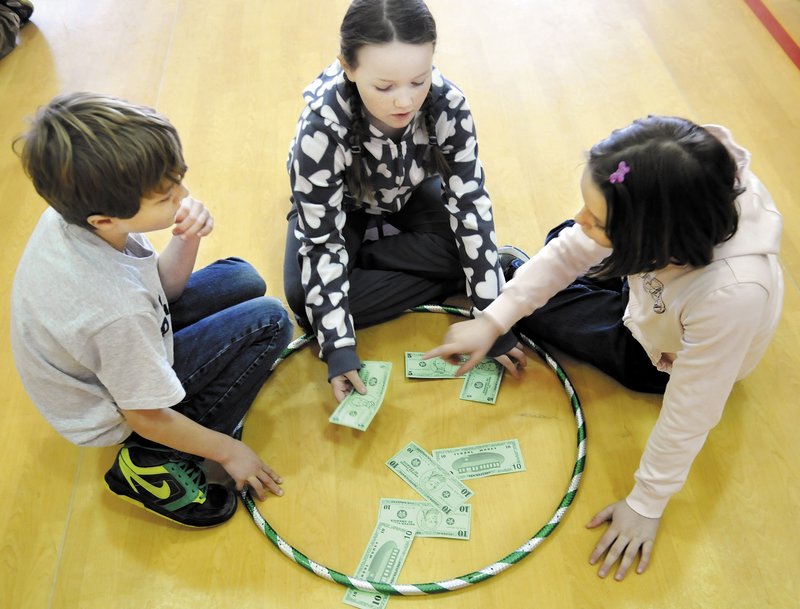It was a mad scramble on scooter carts to reach the play money scattered on the gymnasium floor.
Third-graders at Whitefield Elementary elevated their heart rates by pushing themselves around the floor on the carts during a cops-and-robbers type game in physical education class.
They also exercised their brains as they stacked the bills by denomination and counted by 10s, fives and ones.
Physical education teacher Jamie Simpson has introduced several mathematics-related activities to her classes this year, but she tries not to talk too much about the academic content with students.
“It’s supposed to be fun, and they don’t necessarily think that the learning part of school is fun,” she said. “I think a lot of times, they don’t even understand that they’re learning while they’re here.”
To third-grader Griffen Bond, however, the math was part of the fun of the bank robbery game.
“It’s active, and we get to count,” he said. “It’s math and activity blended together.”
In an age of high-stakes standardized testing, some schools are trying to maximize academic instruction by incorporating mathematics and literacy skills into physical education. Keeping score and counting laps have always been part of phys ed, but teachers such as Simpson and Scott Colby at Williams Elementary in Oakland are trying to go more in-depth.
As part of a schoolwide focus on mathematics this year at Williams, the grades 3-5 school added extra phys ed periods on Thursdays and Fridays for classes that integrate both subjects.
“We call it ‘math movement,’ for lack of a better phrase because that’s what we’re doing. We’re combining math skills and movement skills,” Colby said.
After three decades teaching phys ed, Colby wasn’t sure how well it would work, but he said he’s seeing all kinds of benefits he didn’t expect, from the fun students are having to the things he’s learning about mathematics instruction.
“It’s been great for the collaboration within the building,” Colby said. “I very often don’t really know what they’re studying in math or reading, and they (other teachers) in turn don’t know about the skills I’m teaching in phys ed.”
Some of the new activities Colby has introduced this year add an extra wrinkle to counting. During indoor bowling, for example, he had students count their scores down from 150 instead of up from zero. Some teams knocked down enough pins that they got practice subtracting past zero and into negative numbers.
Other games are entirely new, such as asking students to solve a money problem — $1.50 minus 35 cents, for example — and then having them race around the gymnasium to collect and spell out the answer with ping-pong balls inscribed with numbers and symbols.
Simpson teaches kindergarten through eighth grade at Whitefield, so her mathematics-related activities vary widely. She recently taught first-graders to tally numbers and practice counting by fives, while middle-school-age students calculate their heart rates and their progress toward fitness goals.
Third-grade teacher Tracy Northrup said the games are a fun way for her students to reinforce skills they learned in earlier grades.
“This is a smart group,” she said, “so they like to be challenged, and they like that extra piece in the phys ed.”
The addition of mathematics to phys ed at Whitefield this year is part of the school’s participation in a federal Teacher Incentive Fund grant, which is supporting the development of a performance-based compensation system.
Whitefield has schoolwide goals for student growth in mathematics and literacy, and the use of mathematics-based games is a way for a non-academic teacher such as Simpson to contribute.
Principal Josh McNaughton said the teachers in other non-academic subjects also have incorporated more mathematics and literacy into their classes this year.
In music, for example, students might read short geography texts about the culture of origin for different instruments.
Susan McMillan can be contacted at 621-5645 or at:
smcmillan@mainetoday.com
Send questions/comments to the editors.



Success. Please wait for the page to reload. If the page does not reload within 5 seconds, please refresh the page.
Enter your email and password to access comments.
Hi, to comment on stories you must . This profile is in addition to your subscription and website login.
Already have a commenting profile? .
Invalid username/password.
Please check your email to confirm and complete your registration.
Only subscribers are eligible to post comments. Please subscribe or login first for digital access. Here’s why.
Use the form below to reset your password. When you've submitted your account email, we will send an email with a reset code.